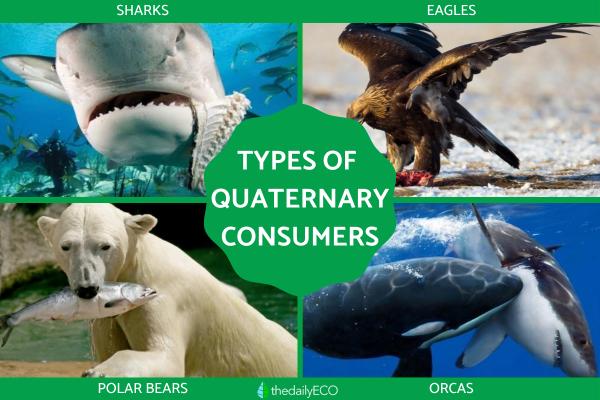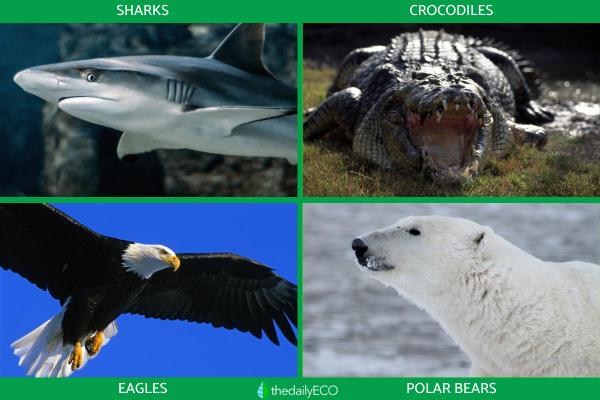
Every ecosystem has different food chains which helps us to understand the biocenosis of the living organisms within it. This refers to the interactions of living organisms in a given geographical area. Energy transfers between producers and consumers within the food chain, but not all are equal in terms of how much they produce or consume, respectively. These are the different trophic levels within a food chain, which also include decomposers. These break down dead organisms and release their nutrients into their environment.
With this in mind, we look in more detail at the component organisms of a food chain by asking what is a quaternary consumer in a food chain? We explain how these consumers fit into the food chain, as well as provide examples of quaternary organisms in nature.
What are quaternary consumers?
Quaternary consumers are the animal species that are at the very top a given food chain, also known as superpredators. They are not hunted by predators other than those of the same species.
Considered a type of heterotrophic species, they consume consumers lower down in their respective food chains. They are generally hypercarnivores, eating only other animals for sustenance. A hypercarnivore eats more than 70% of meat in their diet, although some quaternary consumers ma also supplement their diet with non-animal food, especially during times of scarcity.
As they have no natural predators, quaternary consumers are the least abundant group in an ecosystem. They need more animals to eat since they cannot survive otherwise. Sometimes the term ‘quaternary consumer’ is not used. They are considered apex predators, but this is seen as a type of tertiary consumer. Quaternary consumers can be a useful term to distinguish their rarity and specialness in a food chain.
Consumers only survive thanks to producer organisms lower down in the food chain which feed other consumers. Our related guide explains what are producer organisms in biology?
Examples of quaternary consumers
Quaternary consumers can live in a wide variety of ecosystem, both aquatic and terrestrial. This also includes aerial-terrestrial, since some quaternary consumers are birds:
Examples of aquatic quaternary consumers
- Sharks: if we were to ask ourselves what type of consumer is a shark, some may consider them a tertiary consumer. It is help to use the quaternary consumer category, since they can even feed on other sharks. Among other organisms they feed on are fish, mollusks, plankton, and crustaceans. There are some shark species that consume practically any type of life, without distinction. They include the hammerhead, mako and bull sharks.
- Crocodiles: these are also quaternary consumers. When they are young, their diet is primarily based on smaller animals such as crabs, small amphibians, insects and small fish. As crocodiles grow, they feed on other reptiles, birds and even large mammals that come to the shore to drink.
- Orcas: also known as killer whales, these are not actually whales. They are the largest type of dolphin species and are entirely carnivorous. Due to their diet, size and highly developed hunting ability, they are considered quaternary consumers. Only other orcas can attack them and this is rare, making them the top predator of the sea.
Examples of terrestrial Quaternary consumers
- Eagles: these are hunting birds that prey on animals such as rabbits, snakes, other birds and rodents, among others. They can also be scavengers if there is a shortage of animals to hunt.
- Polar bears: they are carnivores that require large daily food intakes. It is estimated that a polar bear requires 66 lb (30 kg) of food per day. They are large predators that feed primarily on reindeer and seals. They will eat each other when there is a shortage of prey. Cannibalism among polar bears used to occur only very rarely, but due to the effects of climate change, these cases are becoming more frequent.
- Human beings: people are also consumers at the top of the trophic pyramid, since we are omnivorous animals that feed on a wide variety of species and have no direct predators. We are consumers that consume much more energy than we contribute to the food chain, which is why another reason why recognizing quaternary consumers as being different to tertiary consumers can be useful.
Learn more about how consumers behave with our article on the differences between predator vs. prey.

Why there are there few quaternary consumers in ecosystems?
Nature seeks its own balance and naturally establishes its own order. In natural systems, the number of quaternary consumers is lower because they are the ones that consume the most energy, as well as being the ones that produce the least energy.
In the food chain, there is a flow of energy that passes from one trophic level to another. As this energy passes across levels, some is lost. This is why there are a greater number of producers, being greater than that of primary consumers. It is also why there are also more primary consumers than secondary, more secondary than tertiary and more tertiary than quaternary.
Furthermore, considering that quaternary consumers are large predators with a very broad diet, they feed on virtually any herbivore, omnivore or other carnivore. If there were a large number of this type of consumer, the remaining consumers would be seriously threatened. The number of other species would be reduced, destabilizing the entire food chain.
Each ecosystem needs to maintain its own balance to survive. Affecting the numbers and types of both producers and consumers can result in imbalances which cause detriment to this ecosystem. Learn more about maintaining this balance with our guide to the different types of ecosystems.
What are primary, secondary, tertiary and quaternary consumers?
In addition to quaternary consumers, within the food chain we find other types of consumers:
- Primary consumers: the species that form the first group of consumers are herbivorous species. They are heterotrophic animals that require organic matter for food. They obtain this organic matter from plant species, plants being the producer link in the food chain. Some examples include herbivorous birds, rodents and small amphibians. Discover more about the types of herbivorous birds we can find in various ecosystems.
- Secondary consumers: this group includes both omnivorous and carnivorous species, all of which are heterotrophic, meaning they obtain organic matter for their food. They do so by feeding on species that belong to the primary consumers, controlling their population size as they do so. Some examples include domestic cats, pumas and owls. Discover more about what are heterotrophic animals in our related guide.
- Tertiary consumers: this group is made up of carnivorous species. They are heterotrophic animals that consume organic matter to obtain their energy. They obtain organic matter from secondary and some primary consumers, thus controlling this population. Indirectly, they also affect the remaining trophic levels. Some examples of tertiary animals are the fox, seals and sea lions, among others.
- Quaternary consumers: as discussed above, these are animal species found at the top of the food pyramid and can feed on all consumers. Examples of this type of consumer are humans and sharks.
Food chains contain different trophic levels, but even food chains exist only within larger food webs. Discover more about how organisms, energy and biomass are distributed with our article asking what are ecological pyramids?
If you want to read similar articles to What Is a Quaternary Consumer in a Food Chain?, we recommend you visit our Biology category.